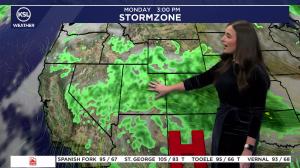Estimated read time: 7-8 minutes
This archived news story is available only for your personal, non-commercial use. Information in the story may be outdated or superseded by additional information. Reading or replaying the story in its archived form does not constitute a republication of the story.
ARCO, Idaho (AP) — Volcanic rocks the size of footballs slid and bounced down a steep lava slope. At the top, a team of geologists, biologists and NASA engineers had just climbed the hill of jagged rock known as the North Highway Flow.
The team is FINESSE, short for Field Investigations to Enable Solar System Science and Exploration. Its goal at Craters of the Moon National Monument and Preserve: Conduct field experiments and procedures that may be used by NASA, which plans to land astronauts on Mars in the 2030s, according to the Twin Falls Times-News (http://bit.ly/1JMwzYH )
The team worked alongside another from Biologic Analog Science Associated with Lava Terrains, BASALT. That program's goal: Look at the habitability of terrains similar to Mars.
Both are headed by the NASA Ames Research Center and began a combined five-year project at Craters of the Moon in 2014.
The teams include scientists and engineers from NASA facilities throughout the country as well as educators from Idaho.
For the first two weeks of August, they worked together, combining a variety of projects into a holistic, analog study of Mars and other planetary bodies.
At Craters of the Moon, they conducted experiments at the North Highway Flow, King's Bowl lava field and other geologically significant locations. They took rock samples and tested $1 million in equipment to better prepare for human and robotic explorations throughout our solar system.
NASA views Craters of the Moon as an analog to the moon, Mars and other planetary bodies. The North Highway Flow's silicon- and titanium-rich lava rocks are the result of an eruptive period along the Great Rift 2,000 years ago. Its rocks represent some of the youngest in all of Craters of the Moon.
Though much of the actual moon's craters are the result of meteorite impact, the melted material there has flows similar to the park's.
What the researchers can learn at Craters of the Moon may preview what's on other planetary bodies.
. . .
At Craters of the Moon, molten rock, or magma, came up from deep in Earth's lower crust or upper mantle, mixing with other rocks as it rose. Today's scientists find little chunks of lower crust that got into magma 15-25 kilometers deep before the magma reached the surface.
There's a range of surfaces from smooth to rough to really rough, said Scott Hughes, project leader and Idaho State University professor emeritus.
Understanding the causes of this surface variety clues researchers into how the terrain on planetary bodies, particularly Mars, was formed.
"Craters of the Moon lava is some of the roughest, if not the roughest in the planet," Hughes said. "We have found that the variability from one place to the next on any lava flow may be greater than we anticipated."
At the North Highway Flow on Aug. 6, the researchers slowly dragged a 6-foot pole with an attached differential GPS, DGPS, to map the flow's topography. They formed another transect at a 90-degree angle.
To do so required passing the equipment from person to person in a straight line, and without tipping, across sharp, loose rocks. It measured data points every 15 centimeters.
If the pole was even slightly tipped, the data points would measure extra distance that the researchers didn't mean to record.
After those measurements, researchers take the text file that the DGPS creates and convert it in Microsoft Excel, where the file displays as a graph. Dramatic spikes in the graph, like the ones produced from the North Highway Flow, reflect the shape of its terrain.
"We call it Mordor because it just looks so vicious to cross," project co-lead Shannon Kobs-Nawotniak said. "And it is really vicious."
The GPS survey team needed to compare its data with satellite images to see how the latter translates to actual ground results.
The day before, a team from the Kennedy Space Center flew an unmanned aerial vehicle (UAV) above the same area and took images that suggested the terrain was passable.
That team, too, was comparing its data with satellite imagery — what is referred to as "ground truthing." By ground truthing, the teams know to what extent they can rely on satellites to accurately map the terrain of Mars and other planets.
"It's going to help for potential manned missions to Mars," Kobs-Nawotniak said. "It's going to help put rovers on different planets."
Using the data taken from the DGPS and UAV helps NASA determine what data scales indicate a surface that a rover can land on without being damaged. It also helps NASA understand what surfaces, based on data images, humans can travel across.
"The idea is we're not going to have that level of inaccuracy," said Jeff Karlin, a science teacher from Lewiston High School working with FINESSE. "All of these instruments work together."
. . .
Karlin was out at the North Highway Flow with the DGPS on Aug. 6. It was his fifth trip to Craters of the Moon and his second time with the NASA teams. Like many of the researchers, Karlin floated around to different projects.
He also spent time collecting rock samples in the lava fields, learning how lava flows differ subtly in composition. To do so, Karlin and other researchers used large hammers to knock off corners of the rocks.
They collected little chips to samples the size of baseballs. Each part broken off was documented, in addition to every piece that was affected but not sampled. The teams tried to minimize damage to the national monument.
They used spectrometers to read the elemental composition of each sample.
"The sampling project is really important because we want to connect these textures — how the material of the rock influences these textural changes," Kobs-Nawotniak said. Changes tell the researchers how fast lava was flowing relative to its viscosity.
As lava gets farther from vents, it cools and breaks up as it flows. Different lava flows go through that transition at different times and distances based on factors such as weather or the land's slope.
Sampling at Craters of the Moon clues researchers on how some of the lava flows formed on Mars.
Some of the samples will be taken to Idaho State University to be cut into pieces that look like dominoes and viewed with high-powered microscopes. Other samples will be ground down and used for X-ray fluorescence to determine the elements and chemicals present.
"The secondary rock samples we gathered were so we could do a new activity: thermoluminescence dating," Karlin said. "If you take the rocks and you're looking at them with thermoluminescent images, you can date them."
This process measures radiation doses in crystalline materials to determine time elapsed since the sample was heated by lava.
Karlin said it's about tendencies. If certain changes in composition exist at Craters of the Moon, they should exist on other planets under similar conditions.
. . .
The FINESSE and BASALT teams will continue at Craters of the Moon for three more summers.
In June 2016, the BASALT project will add a simulation of Martian conditions at the park. It aims to bring two active astronauts from the Canadian Space Agency.
The CSA astronauts will also train with simulated time delays on communications systems. It'll help space agencies figure out effective, timely ways to communicate with large groups as humans are landed on Mars.
The goal is to train the astronauts on simple field geology — much as in 1969, when astronauts selected for the Apollo 14 mission visited Craters of the Moon for training.
"The last thing we want is for them to get out (to Mars) and it's just space tourism," Kobs-Nawotniak said. "We want to train people to look for what things are important — what tools do they need to be successful out there?"
___
Information from: The Times-News, http://www.magicvalley.com
Copyright © The Associated Press. All rights reserved. This material may not be published, broadcast, rewritten or redistributed.







